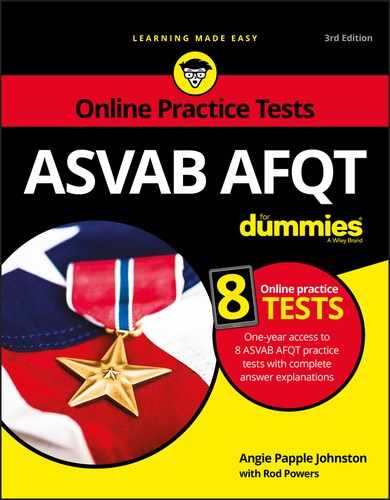Chapter 16
Practice Exam 2: Answers and Explanations
The answers and explanations in the following sections help you determine how well you performed on the practice test in Chapter 15 — and give you some hints about where you may have dropped a decimal point or two. Don’t worry; it happens to the best of us.
Don’t focus too much on scores. On the actual AFQT, harder questions are worth more points than easier questions. The AFQT is one of those rare tests on which you can miss some questions and still max out your test score. As always, use the results to decide where you want to concentrate your study time. Do you need more work on math or reading and verbal skills? This chapter helps you find out.
If you want to skip the explanations for now and see which questions you got right or wrong, go to the Answer Key at the end of the chapter.
Part 1: Arithmetic Reasoning
The Arithmetic Reasoning subtest is not only one of the important subtests that make up the AFQT, but it’s also used as a qualification factor for many of the military jobs you can choose from. You may want to glance at ASVAB For Dummies by Rod Powers and Angie Papple Johnston (published by Wiley) to see which military jobs require you to do well on this subtest.
If you missed more than five or six questions on this practice test, it’s time to dig out that old high-school math textbook and wrap your brain around some math problems. Chapters 9 and 11 can also help you out. Some other great books that may help you score better on this subtest include Math Word Problems For Dummies, Algebra I For Dummies, and Algebra II For Dummies, all by Mary Jane Sterling; Basic Math & Pre-Algebra For Dummies by Mark Zegarelli; Geometry For Dummies by Mark Ryan; and SAT II Math For Dummies by Scott Hatch, JD, and Lisa Zimmer Hatch, MA — all published by Wiley.
-
C. 85 ft
Marty has 200 feet of fencing and wants to fence in a rectangular yard. If the yard is to be 15 feet wide, then use the formula for perimeter to find the length:

You can check your work by plugging the numbers for length and width back into the equation to make sure the answer comes out to 200 or less (the total amount of fencing Marty has).
-
A. 60 in.
First, find 25 percent of 48:
 . (Instead of multiplying 48 by 0.25, you can also recognize that 25 percent is equal to
. (Instead of multiplying 48 by 0.25, you can also recognize that 25 percent is equal to  of something and simply divide 48 by 4 to arrive at the same answer.) Henry’s brother’s height is
of something and simply divide 48 by 4 to arrive at the same answer.) Henry’s brother’s height is  .
. -
C. 144
Together, Janet and Alice collected 329 cans:
 . Because the group collected 473 cans, subtract Janet and Alice’s total to find how many cans Gabriel collected:
. Because the group collected 473 cans, subtract Janet and Alice’s total to find how many cans Gabriel collected:  .
. -
B. 14 ft
The area formula for a rectangle is
 , where
, where  ,
,  , and
, and  . Substitute the known values into this formula and then isolate w by dividing both sides by 12:
. Substitute the known values into this formula and then isolate w by dividing both sides by 12: 
-
C. 300
A decameter equals 10 meters, so 3 decameters equals 30 meters. Because there are 10 decimeters in a meter, you multiply that number by the total number of meters:
 in a decameter.
in a decameter. -
A. 7°F
Because the temperature increased, add to find the outside temperature at noon:

-
A. 120 mph
The distance formula is
 , where d is the distance, r is the rate, and t is the time. In this problem, you can save time by using fractions instead of decimals (that’s not always the case, though). Turn 1.5 (the time the plane flew) into an improper fraction:
, where d is the distance, r is the rate, and t is the time. In this problem, you can save time by using fractions instead of decimals (that’s not always the case, though). Turn 1.5 (the time the plane flew) into an improper fraction: 
Replace the variables with the values you know and cancel out everything you can:

If you’re not good with fractions, it’s okay to stick with the decimal. Substitute the known values into this formula and then isolate r by dividing both sides by 1.5:

-
D. 20
Let
 the number of trucks, and express the two ratios of cars to trucks as a proportion. So
the number of trucks, and express the two ratios of cars to trucks as a proportion. So  because you know there are 15 cars. Cross-multiply to solve for x.
because you know there are 15 cars. Cross-multiply to solve for x. 
-
D. $2.80
Forty percent of 2 pounds is
 . The amount he paid for the raisins is
. The amount he paid for the raisins is  .
. -
C. 42
If x is Patricia’s age, then Ms. Chang’s age is 3x. Set up the equation and solve for x:

Patricia’s age is 14, so Ms. Chang’s age is
 . To double-check, add the two ages together to make sure they equal 56 as the problem indicates:
. To double-check, add the two ages together to make sure they equal 56 as the problem indicates:  .
. -
D. $120.00
Ed’s hourly rate is
 per hour. John’s hourly rate is
per hour. John’s hourly rate is  . For 10 hours of work, John earns
. For 10 hours of work, John earns  .
.You can skip working out Ed’s hourly rate if you multiply the $0.50 difference in the men’s hourly wages by 10 hours of work
 and subtract that from Ed’s total earnings:
and subtract that from Ed’s total earnings:  .
. If you find a shortcut that works for you — and that you’ll remember on test day — use it. But if you’re a little shaky on the details, stick with what you know so you don’t make mistakes that drop your AFQT score.
If you find a shortcut that works for you — and that you’ll remember on test day — use it. But if you’re a little shaky on the details, stick with what you know so you don’t make mistakes that drop your AFQT score. -
B. 1.25 ft
The length of one side of the square game board is
 inches. There are 12 inches in 1 foot, so 15 inches is 1 foot and 3 inches, or
inches. There are 12 inches in 1 foot, so 15 inches is 1 foot and 3 inches, or  .
. -
B.

Write each mixed number as an improper fraction. To do so, multiply the denominator by the whole number and then add the result to the numerator:

Write the fractions using a common denominator, and then subtract to find the amount of milk you need. The common denominator is 4 because 4 is the least common multiple (LCM) of 4 and 2:

Another approach is to add to the first amount
 until you reach the second amount
until you reach the second amount  . If you add
. If you add  cup, you’ll hit an even 2 cups; another
cup, you’ll hit an even 2 cups; another  cup will bring you to
cup will bring you to  cups. Add the fractions
cups. Add the fractions  to see how much milk you added altogether:
to see how much milk you added altogether: 
-
C. 4 percent
Use the interest formula
 , where I is the interest, p is the principal, r is the interest rate (as a decimal), and t is the time in years. Substitute known values into the formula and solve for r.
, where I is the interest, p is the principal, r is the interest rate (as a decimal), and t is the time in years. Substitute known values into the formula and solve for r.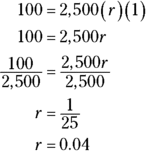
Write 0.04 as a percent by moving the decimal point two places to the right:
 .
. -
A. 72 cm2
Divide the region into two rectangles and find the length of the missing sides.

Illustration by Thomson Digital
The formula for the area of a rectangle is
 . Find the area of the upper rectangle and add it to the area of the lower rectangle.
. Find the area of the upper rectangle and add it to the area of the lower rectangle.Upper rectangle:

Lower rectangle:

The area of the total region is
 .
. -
C. 35
If 60 percent of Martha’s cooking class is equal to 21 people, you must find the total number of students by using x for the total number of people in the class.
Write the equation like this:

Divide both sides by 0.60:

There are 35 total students in the class.
You can also set up a proportion if you know that
 :
:
Increase the terms of the first fraction to get to the second; you get 21 by multiplying 3 by 7, and multiplying 5 by 7 gives you 35, so x = 35.
-
D. 5:10 p.m.
The distance formula is
 , where d is the distance, r is the rate, and t is the time. Substitute the known values and solve for t to find out how long Keisha walked:
, where d is the distance, r is the rate, and t is the time. Substitute the known values and solve for t to find out how long Keisha walked:
One hour and 30 minutes after 3:40 p.m. is 5:10 p.m. Add one hour to 3:40 p.m. to arrive at 4:40 p.m., and then add another 20 minutes to get to 5:00 p.m. Add the remaining 10 minutes to reach 5:10 p.m.
-
B.

The amount you earn is the product of your hourly rate and the number of hours worked, which you can express as $9.75h. Your earnings must be greater than or equal to $150, which is represented by the symbol
 .
. 
-
A. 4 m
Let
 the length of Carlos’s father’s truck. The ratio of the model length to the length of the actual truck should equal the ratio of 2 centimeters to 0.25 m. Set the two ratios equal to each other to make an equation. Cross-multiply to solve for x.
the length of Carlos’s father’s truck. The ratio of the model length to the length of the actual truck should equal the ratio of 2 centimeters to 0.25 m. Set the two ratios equal to each other to make an equation. Cross-multiply to solve for x.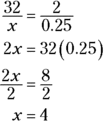
In the equation above, an easy way to multiply 32 by 0.25 is to divide 32 by 4 (because
 ).
). -
A. $59
Use a sequence of numbers to represent the cost of the paintings in order from left to right. The first number on the left is 29. Add 15 to find the cost of the next painting: 29, 44, 59. The painting on the far right costs $59.
If it’s easier, round 29 up to 30, add 15 three times, and subtract $1 at the end:


-
B. 12 hours
Find how many hours it will take Megan to travel by using the distance formula
 , where
, where  and
and  :
:
It will take Megan 12 hours to get to her grandmother’s house.
-
B. 75 mph
Substitute
 into the formula and solve for x:
into the formula and solve for x: 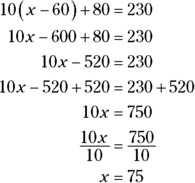
-
B. 24 mpg
Subtract to find the number of miles traveled:
 . The car’s gas mileage is the distance traveled divided by the number of gallons of gas used:
. The car’s gas mileage is the distance traveled divided by the number of gallons of gas used:  .
. -
A.

The formula for the volume of a cylinder is
 , where r is the radius and h is the height. The radius of the can is equal to half the diameter:
, where r is the radius and h is the height. The radius of the can is equal to half the diameter:  . Substitute known values into the formula to find the volume:
. Substitute known values into the formula to find the volume:  .
. -
B. $1,310
Subtract the co-pay for one visit from the cost of one visit:
 . The insurance company pays 60 percent of the cost after the co-pay, so Matt pays 40 percent of the cost. Find 40 percent of $290:
. The insurance company pays 60 percent of the cost after the co-pay, so Matt pays 40 percent of the cost. Find 40 percent of $290:  . Add Matt’s portion after the co-pay to the co-pay:
. Add Matt’s portion after the co-pay to the co-pay:  total for each visit. Multiply Matt’s total cost for one visit to the chiropractor by 10:
total for each visit. Multiply Matt’s total cost for one visit to the chiropractor by 10:  .
. -
C. 12 minutes
You can figure out how long it will take Marco and his brother to change a tire together by determining how much work each person does in a set amount of time. Use one hour (60 minutes) to keep it simple: Marco can repair one tire in 20 minutes, so he can finish three tires in an hour. His brother can repair two tires in one hour.
In one hour together, they repair

The number of tires is expressed in the numerator, and the unit of time is expressed in the denominator. Because they can repair five tires in one hour together, divide the 60 minutes of an hour by 5 to get the time it takes them to repair just one:

-
D. 12 oz
First, find out how many ounces of water ten squeezes of the trigger emit:
 . That means 0.24 ounces of water is 2 percent of the total amount of water that the bottle can hold.
. That means 0.24 ounces of water is 2 percent of the total amount of water that the bottle can hold.Let
 the total number of ounces of water that the bottle will hold. You know that 2 percent of x is equal to 0.24, so write an equation and then solve for x.
the total number of ounces of water that the bottle will hold. You know that 2 percent of x is equal to 0.24, so write an equation and then solve for x. 
-
C. 1,800 cm2
A shoe box is a rectangular box. The formula for the surface area of a rectangular box is
 , where
, where  ,
,  , and
, and  . Substitute the known values into the formula and simplify.
. Substitute the known values into the formula and simplify. 
-
A. 1 hour
You could create an algebraic equation and a chart to solve this problem, but the question is really asking you how far apart the runners will be in one hour. The first runner can run 5 miles per hour, and the second runs 6 miles per hour — and they’re running in opposite directions. That means in one hour, they’re
 miles apart.
miles apart.For more complex problems, algebra comes in handy. You could solve this problem by letting x represent the amount of time the runners take to run 11 miles in opposite directions and then making a chart to help solve the problem.

Illustration by Thomson Digital
You need to figure out how far each runner ran; you can use a variation of the distance formula,
 , where
, where  ,
,  , and
, and  . The table shows you that Runner 1 will run a distance of 5x and Runner 2 will run a distance of 6x. Because they are running in opposite directions and you want to know when they are 11 miles apart, you add the two distances together and set the sum equal to 11. The equation looks like this:
. The table shows you that Runner 1 will run a distance of 5x and Runner 2 will run a distance of 6x. Because they are running in opposite directions and you want to know when they are 11 miles apart, you add the two distances together and set the sum equal to 11. The equation looks like this: 
It will take the runners 1 hour to get 11 miles apart.
-
C. $84
Use the amount of pizza eaten to determine how many pizzas the coach bought. Excluding the coach, the team ate
 pizzas. Add the amount of pizza the coach ate and the amount of pizza left over:
pizzas. Add the amount of pizza the coach ate and the amount of pizza left over:  . Convert the remaining pizza
. Convert the remaining pizza  to an improper fraction:
to an improper fraction:  .
.Come up with a common denominator and add to find the total number of pizzas:

For 7 pizzas, the total cost before tax is
 .
.If it’s easier, you can add the fractional and whole parts of the pizza separately. If you add the players’ pizza as a fraction, the coach’s pizza, and the fractional part of the leftover pizza, then add the sum to the whole pizzas, your calculation looks like this:

Part 2: Word Knowledge
The Word Knowledge subtest is nothing more than a vocabulary test. However, it can be hard for some people. The good news is that vocabulary isn’t an innate talent. It’s something that everyone can improve. If you find you need to improve your vocabulary, see Chapter 5. A couple of other great study references are Vocabulary For Dummies by Laurie E. Rozakis (Wiley) and SAT Vocabulary For Dummies by Suzee Vlk (Wiley). Additionally, see Chapter 6 for more practice questions.
-
C. detest.
Savor is a verb that means to appreciate something.
“Simón wanted to savor every bite of the meringue.”
-
C. mediocre.
Lackluster is an adjective that means lacking life or energy.
“The actor gave a lackluster performance during his audition, so he didn’t get the part.”
-
A. abstain.
Participate is a verb that means to take part in.
“Marie didn’t want to participate in marriage counseling after her husband had an affair.”
-
B. mess up.
Organize is a verb that means to coordinate or make orderly.
“Cheryl took one look at the messy room and began to organize everything into neat stacks.”
-
D. messy.
Unkempt is an adjective describing something disorderly.
“Tina’s bedroom was so unkempt that Cheryl had to come in and organize it.”
-
B. first
Preliminary is an adjective describing something introductory.
-
B. unavoidable
Inevitable is an adjective that means bound to happen.
-
D. sign
Omen is a noun describing something prophetic.
-
C. cold
As used in this sentence, frigid is an adjective meaning extremely cold.
-
B. oppressor
Tyrant is a noun describing someone who rules over others unjustly.
-
C. phony.
As used in this sentence, counterfeit is an adjective meaning fake or forged.
“When the criminal tried to pay for his dinner with a counterfeit $100 bill, the server called her manager.”
-
A. relieve.
Used as a verb, burden means to provide a load or a difficult task to someone. It’s also a noun that refers to something that’s carried, or a duty or responsibility.
“Robert thought that his complaints about work would burden his wife.”
-
D. subdue.
Used as a verb, animate means to rouse or make lively.
“Playing loud, happy music animated the kids in gymnastics class.”
-
C. reasonable.
Plausible is an adjective that means something looks to be true or believable, though it may or may not actually be so.
“The defendant’s self-defense claim wasn’t plausible, so the prosecutor encouraged the jury to find the man guilty.”
-
B. flexible.
Pliable is an adjective that means easily bent or changeable.
“Good leather is pliable, so it won’t crack when you mold it into a saddle.”
-
B. acceptance.
Resignation is a noun that means a reluctant agreement.
“In the famous movie, William Wallace accepted his terrible fate with resignation.”
-
C. destroy.
Obliterate is a verb that means to demolish or annihilate.
“The goal is to obliterate the enemy’s communication abilities so they can’t conduct military operations.”
-
B. abide.
Heed is a verb meaning to take warning or advice in earnest.
“Pilar told Beto to heed her warning about the cat’s aggression because she didn’t want him to get scratched.”
-
A. massive
Immense is an adjective meaning very large or colossal.
-
A. follow
Pursue is a verb meaning to go after something or someone.
-
C. sensitive
Tactful is an adjective that means being thoughtful or delicate.
-
A. tolerate
Endure is a verb that means to bear with patience or tolerate, or to hold out against.
-
D. endurance
In this sentence, longevity is a noun meaning a prolonged ability. It can also refer to length of service or tenure, or the length or duration of life.
-
B. comfort
Console is a verb that means to alleviate or lessen grief, sorrow, or disappointment.
-
C. scatter
Disperse is a verb that means to move in different directions.
-
D. covered.
Enshrouded is a verb meaning to encompass or obscure something.
“The sun went down, and soon we were enshrouded in darkness.”
-
A. disown.
Repudiate is a verb that means to reject as having no authority or strongly deny something or someone.
“The judge knew he would have to repudiate the man’s claim.”
-
C. indirect.
Oblique is an adjective meaning not straight or not straightforward.
“The candidate made only oblique references to the scandal.”
-
A. agree with.
Acquiesce is a verb meaning to consent by way of giving in.
“Two of the six partners had to acquiesce because the other four (the majority) had already agreed on the plan.”
-
B. flimsy.
Tenuous is an adjective describing something weak or lacking substance.
“The man’s adult stepson had a tenuous claim to the inheritance, so the court would have to decide one way or the other.”
-
C. rampant
Unbridled is an adjective meaning unrestrained.
-
C. exclude
Ostracize is a verb meaning to leave out intentionally.
-
A. full.
Replete is an adjective that means ample or fully supplied.
“The book was replete with detail, describing every character and scene so readers could really envision them.”
-
B. mystery.
Enigma is a noun that means something puzzling, not clear, or not understandable.
“The private millionaire, who rarely leaves his house, is an enigma to everyone in town.”
-
A. pacify
Assuage is a verb meaning to pacify or lessen the intensity of something.
Part 3: Paragraph Comprehension
The Paragraph Comprehension subtest can be a bit tricky, but you need to get a good score on this subtest if you want to ace the AFQT. Pay special attention to your reading skills if you missed more than a couple of these answers — you need some study time (see Chapter 7). Remember that rereading the paragraph several times to make sure that you have the right answer is perfectly fine. The best method of improving your reading comprehension skills is simply to read more. You can find additional practice questions in Chapter 8.
-
D. Trainers should avoid becoming emotional.
The first sentence states the point: “Dog training isn’t for the faint of heart.” In other words, sometimes you have to discipline the dog without becoming an emotional wreck.
-
A. determination
The last sentence of the passage lets you know that your resolve will be tested because you may feel guilty for training your dog. You have to be very determined to train your pet because pity could make you want to drop everything and play.
-
C. 1
A scan of the passage shows you that it clearly says “including one Daytona 500 race.” You can answer questions like these quickly on the ASVAB, so read the question thoroughly, find your answer, and move on.
-
B. severe.
The description of the mood swings states that moods range from a heightened place to an extreme state of depression. Severe is the only word that describes the large range experienced.
-
C. 4
The passage states that rugby has been added and dropped three times but was added back in 2016. The first three times plus the most recent equals four times rugby has been added to the Olympic Games.
-
D. Brazil
The passage lists many locations, but careful scanning shows you that the 2016 Olympics were in Rio de Janeiro, Brazil.
-
C. Breadmaking is more exact than cooking.
The paragraph gives examples of how making bread, unlike cooking, uses exact measurements and ratios to get the desired result. The last sentence also states the answer in different terms.
-
B. outlawed.
The paragraph states that the number of bald eagles continued to decline despite trapping and killing having been barred. The term despite tells you that barred signifies an action against trapping and killing. In fact, the act banned, or outlawed, those practices against the eagle.
-
A. 1972
The passage indicates that DDT was responsible for the decline of the species. Thus, the banning of DDT in 1972 would be the beginning of the repopulation of the bald eagle. You may have been tempted by 1940, but the congressional act didn’t contribute to the population regrowth. When an ASVAB question asks you for a specific date, scan the paragraph quickly for numbers; you’ll be able to find the answer easily.
-
C. Joining the Joffrey Ballet is Jill’s life’s goal.
Although many of these things could be true about Jill, the question asks for the main point of the passage. The passage stresses the importance of her audition and how being accepted by the Joffrey Ballet would be “a dream come true,” so the main point is that she has been eagerly anticipating this moment for some time.
-
B. have opportunities to make a lot of money.
The paragraph describes the popularity of quilting and mentions contests with best in show prizes reaching $10,000. Therefore, you can assume quilters today can make a good amount of money.
-
D. None of the above
Although areas of the other answers may have depths of less than 4 feet, they can all have deeper areas. Because the seller clearly says the lifeboat should not be used by people who cannot swim, it shouldn’t be used in open water.
-
D. preventing a child from becoming overweight before the age of 5
The information states that children obese at age 5 were more likely to be obese in adolescence. Although the passage doesn’t explicitly state that weight management before the age of 5 is desirable, you can reason that from the information provided. The other three answers aren’t stated in the passage, so you can quickly rule them out as possible answers.
-
A. one-third
The passage states that approximately two-thirds of the children involved in the study remained obese in their later years, so you can reason that one-third became thinner.
-
A. version
The movie is based on the TV show, so an adaptation is another version of the show.
Part 4: Mathematics Knowledge
Some folks find math to be a breeze and can’t understand why the rest of us approach math problems with all the enthusiasm of a trip to the dentist. However, the military considers math skills to be important, and it’s right. If you miss more than four or five questions, you should consider brushing up on your basic math skills — Chapter 9 can help with this. As with the Arithmetic Reasoning subtest, the following For Dummies books may also be of some help: Algebra I For Dummies and Algebra II For Dummies, both by Mary Jane Sterling; Basic Math & Pre-Algebra For Dummies by Mark Zegarelli; Geometry For Dummies by Mark Ryan; and SAT II Math For Dummies by Scott Hatch, JD, and Lisa Zimmer Hatch, MA (all published by Wiley). Chapter 10 also has some additional practice questions.
-
B. 2
A prime number is a number that is bigger than 1 and has only itself and 1 as factors. The number 2 is the only choice that fits the definition of a prime number.
-
C. 0.011
Eleven thousandths is the same as
 . To divide a number by 1,000, move the decimal point 3 places to the left:
. To divide a number by 1,000, move the decimal point 3 places to the left:  .
. -
C. 1.281
When adding decimals, arrange the numbers in an addition column with the decimal points lined up:

When adding the 9s in the hundredths column, remember to carry the 1 to the tenths column.
-
A. 18 ft
An equilateral triangle has three equal sides. The perimeter is the sum of all three sides. To find the length of one side, divide the perimeter by 3:

-
D. 88
Write 40 percent as a decimal:
 . Multiply 0.4 by 220:
. Multiply 0.4 by 220:  .
. -
D. 3.25
Divide 26 by 8 using long division.

-
A. p2
To multiply terms with the same base, add the exponents:
 .
. -
B.

To subtract fractions with the same denominator, subtract the numerators but keep the denominators the same. You can then simplify the difference
 to
to  .
. 
-
A. –9
Get y alone on one side of the inequality symbol by subtracting 2 from both sides:

So y can be any number less than –8. The only answer choice that is less than –8 is –9.
-
B.

Use the distributive property to remove the parentheses. Then add the like terms 3x and 4x.

-
C. 15 ft
Use the Pythagorean theorem
 to find the length of the remaining side. Remember that the hypotenuse, c, is always the longest side of a right triangle. Let a represent the length of the remaining side.
to find the length of the remaining side. Remember that the hypotenuse, c, is always the longest side of a right triangle. Let a represent the length of the remaining side.
Use the positive answer because length is always positive.
-
D. –4
The quotient of 40 and 20 is
 . The sum of 1 and 5 is 6. Decrease 2 by 6 using subtraction:
. The sum of 1 and 5 is 6. Decrease 2 by 6 using subtraction:  .
. -
C. 3
Use the order of operations, which says to simplify inside the parentheses first, compute all exponents, multiply and/or divide from left to right, and then add and/or subtract from left to right. (You might know this order of operations as PEMDAS.) This equation has no parentheses (or other grouping symbols), so start with the exponents:

-
B. 60
To find the least common multiple (LCM) of two numbers, write out the multiples of each number and find the smallest number that they have in common.
Multiples of 12: 12, 24, 36, 48, 60
Multiples of 20: 20, 40, 60
The LCM is 60.
Another way (and one that could save you precious time on the ASVAB) to tackle this problem is to check which answer choices are divisible by both 12 and 20. Start with the smallest answer choice and you’ll find that you can toss Choice (A) right out the window. Try choice (B), and you’ll see that it’s the correct answer.
-
A.

Product means multiplication. When multiplying two fractions, multiply the numerators by each other and multiply the denominators by each other.

Remember to simplify all fractions. Simplify this fraction by dividing the numerator and denominator by the greatest common divisor, 4:

-
D. 24
This question asks for the product of four numbers. You can multiply two numbers at a time. Remember that the product of two numbers with the same sign is positive, and the product of two numbers with different signs is negative.

-
D. 4 only
A cube root is a number that when multiplied by itself three times equals the number under the radical sign. Because
 , 4 is the cube root of 64.
, 4 is the cube root of 64. -
C.

You need to find the common denominator for these two fractions. The common denominator is the least common multiple of 5 and 3.
Multiples of 5: 5, 10, 15
Multiples of 3: 3, 6, 9, 12, 15
The common denominator for these two fractions is 15. Multiply the numerator and denominator of each fraction by the number that makes each denominator 15.
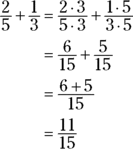
-
B. 86 m2
First, find the area of the square by using the formula
 , where s is the length of one side of the square. Because
, where s is the length of one side of the square. Because  meters, the area of the square is
meters, the area of the square is  .
.Next, find the area of the circle by using the formula
 , where r is the radius of the circle. Because the diameter of the circle runs the length of one side of the square, the radius is half the length of one side of the square, so
, where r is the radius of the circle. Because the diameter of the circle runs the length of one side of the square, the radius is half the length of one side of the square, so  meters. The area of the circle is
meters. The area of the circle is  .
.To find the area of the region inside the square but outside the circle, subtract the area of the circle from the area of the square:
 .
. -
A. 21
Let x represent the middle number. Next, add and subtract 2 (to represent the other odd numbers), written as
 and
and  .
. 
If you’re not big on algebra (surprisingly, it’s not everyone’s favorite subject), you may not need to use it on questions like this one. When you’re adding three consecutive odd numbers, you can reason that each number is going to be close to one-third of the sum, 63:

Check 21 as your middle number to see if it works:

It does, so Choice (A) is correct.
-
D. 4 and –4
This equation is a quadratic equation because the unknown quantity (x) has an exponent of 2. To solve it, first isolate the variable by subtracting 4 from both sides:

Next, take the square root of both sides. (With any positive real number, you’ll get a positive and negative answer to the square root problem, because when you multiply a negative number by a negative number, you get a positive number.)

-
A. 60°
If two angles are supplementary, the sum of their measures is 180°. Label the angle you’re trying to find as x and the supplement as 2x. You can then set up an equation:

-
B.

To solve for x, cross-multiply and isolate the variable:

Use long division to write the answer as a mixed number.

The quotient forms the whole number; the remainder, 9, is the numerator of the fraction, and the divisor, 81, is the denominator:
 . You can simplify this number to
. You can simplify this number to  .
. -
C.

The numerator is a difference of two squares. Use the formula
 to factor the numerator. The factor
to factor the numerator. The factor  cancels out in the numerator and in the denominator.
cancels out in the numerator and in the denominator. 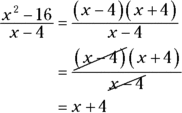
-
D. 52°
The sum of the angles in a quadrilateral always equals 360°. Write an equation to find the value of n:
 .
.To solve this equation, isolate the variable:

Answer Key
Part 1: Arithmetic Reasoning
- C
- A
- C
- B
- C
- A
- A
- D
- D
- C
- D
- B
- B
- C
- A
- C
- D
- B
- A
- A
- B
- B
- B
- A
- B
- C
- D
- C
- A
- C
Part 2: Word Knowledge
- C
- C
- A
- B
- D
- B
- B
- D
- C
- B
- C
- A
- D
- C
- B
- B
- C
- B
- A
- A
- C
- A
- D
- B
- C
- D
- A
- C
- A
- B
- C
- C
- A
- B
- A
Part 3: Paragraph Comprehension
- D
- A
- C
- B
- C
- D
- C
- B
- A
- C
- B
- D
- D
- A
- A
Part 4: Mathematics Knowledge
- B
- C
- C
- A
- D
- D
- A
- B
- A
- B
- C
- D
- C
- B
- A
- D
- D
- C
- B
- A
- D
- A
- B
- C
- D
